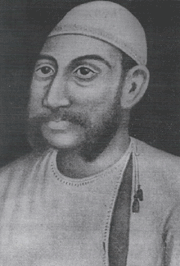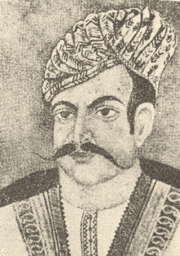 People's Democracy
People's Democracy
(Weekly
Organ of the Communist Party of India (Marxist)
No. 14
April 08, 2007
(Weekly
Organ of the Communist Party of India (Marxist)
|
Vol.
XXXI
No. 14 April 08, 2007 |
AGRARIAN UPRISINGS AND RURAL SOCIETY
The 1857 Rebellion and its Aftermath

Archana Prasad
THE contradictions within the rural society of the first half of the nineteenth century came out in the open with the revolts of the summer of 1857. The sepoy revolt of May 1857 proved to be a catalyst in laying open the crisis of the old feudal order whose rulers made a last attempt to defend their threatened power and authority. However, it would perhaps not be accurate to state that this alliance of different rulers was responsible for the mobilisation of the agrarian population (comprising peasants, tribals, pastoralists etc) against the British regime. Neither were agrarian struggles a new and unique feature of the mid-nineteenth century. Rather the entire nineteenth century has been replete with a multitude of different uprisings in which the rebellion of 1857 was a defining moment because it heralded a new phase of direct colonial rule and domination. Thus the agrarian uprisings after this period also had significant differences with those of the pre-1857 period.
Perhaps the greatest difference in between the revolts of 1857-58 and the early nineteenth century ones lay in their regional focus. Though the agrarian disturbances during the great rebellion spawned through many parts of the country, their focal area was north and central India that had been annexed and put under direct British rule in the late 1840s and early 1850s. Thus Punjab was annexed in 1848, the Central Provinces in 1854 and Awadh and its neighbouring territories around 1856. The erstwhile rulers of these territories and their neighbours provided an important umbrella leadership for the rebellion of 1857 and the defence of their territories. In this sense the alliance of local chiefs and Rajahs countered the penetration of colonial rule in these regions in the same manner as the rebels of eastern India had done in the earlier period under their displaced chiefs.
But within this there were a multitude of mini-rebellions that were varied in their nature and form and provided the substantive mass base of what came to be known as the mutiny of 1857. Amongst the best known revolts was that led by Kunwar Singh, the bankrupt 80-year old Raja of Arrah in Shahbad. By all accounts, Kunwar Singh did not have a strained relationship with the British till the July 1857 sepoy uprising in Dinajpur, but British officials later noted that Kunwar Singh had supported the rebels because of his debts and ruined condition. But the important point to note is that a unity between the cause of the villagers and sepoy rebels was forged under his leadership. The most important participants in this were the peasants from the Rajput villages who supported the mutineers as they forced the indigo planters to flee and released prisoners. Clearly the rebels, who claimed that they were acting on the orders of Kunwar Singh, were attacking European installations which were symbols of oppression of both the peasants and the mutineers. Thus the presence of a local chieftain and leader could lead to the mass support for the revolt of 1857
However the rapid changing nature of rural revolts and the multiple nature of contradictions that unfolded were evident in other areas like Palamau where tribal Chero jagirdars got the support of Bogtah people in their fight against the Thakur who was seen as a close associate of the British. The Cheros provided support to the Ranchi sepoy insurgents who fled to the area and were joined by the Bogtahs who considered the Thakur bigger enemies than the Cheros who were the agents of the Thakur and their direct exploiters. The nature of attacks was once again the symbols of British powers, but the difference in the Chero and Bogtah targets was telling: while the sepoys and the Cheros concentrated on raiding police stations, the Bogtahs concentrated on destroying the stations of mining companies which mainly exploited tribal labour in the region. However, the fragility of the Chero-Bogtah alliance was revealed by December when the main rebels were executed and the Cheros now decided to ally with the British. This facilitated the early demise of the Bogtah rebellion and showed how the long term nature of rural contradictions had overtaken the logic of the great rebellion.
INTERNAL CONTRADICTION

Kunwar Singh, rebellion leader of Jagadishpur
But not all rebellions were strategic alliances between the ruling classes and the peasantry. In fact in many the conflicts between different segments in the rural society came out in the open. Rebellions were often initiated by the poorest people within the peasantry. The rebellions in Muzaffarnagar and Saharanpur districts originated in thirsty tracts where neither canal irrigation nor the money lender had reached and they were places that were recognised as “severely assessed” tracts in period after the Mutiny. The Gujjar peasantry of the Nakur and Gangoh parganas of these regions revolted because they were the ultimate losers in the new system of land assessment and curiously these revolts were confined to the non-irrigated lands. Thus the Gujjar peasantry of the irrigated tracts in the same region did not rebel as vociferously because they could meet their revenue needs in the short term. Thus the process of internal differentiation impacted on the nature of the revolt and affected the nature of the revolt. In Delhi, for example the Meo peasants refused to acknowledge the authority of the rebellious Ahir chief, Rao Tula Ram, who had provided protection to the Jat peasantry with whom the Meos had a direct contradiction. The Mewatti Movement of 1857 thus saw a direct attack on the villages of the Jats, Ahirs and Brahmins by the Meo rebels. The Jats were seen as having benefited the most from the canal irrigation policy of the British.

Rao Tularam, rebellion leader of Haryana
The agrarian uprisings of 1857 should thus be seen in relation to several dialectical processes that were unleashed through a protracted phase of colonial expansion. In the first instance they represented yet one more challenge to the colonial state in the process of its expansion. However what set it apart from other instances was the broad alliance between ruling classes to defend their sovereignty. At the same time the multitude of revolts that provided a mass base for the rebellion were defined by the internal contradictions and crisis of rural society that was a result of the first six decades of colonial expansion. The rebels succumbed not only to the military might of the British, but also the weight of the internal crisis in the older feudal order. By the same measure the failure of the uprisings of the sepoys, rulers and peasantry also proved to be a threshold in the consolidation of colonial rule with the end of the Company rule.
The establishment of the Crown rule in 1858 facilitated the integration of Indian agrarian economy into the world capitalist system and all administrative and political reordering of the rural society was done towards this end. This overall development had a nature on the bearing of the revolts in the late nineteenth century. The commercialisation of agriculture especially in the cotton boom of the 1860s in western and central India or the continued monopoly trade over indigo cultivation and trade in eastern India led to the Deccan riots (1875) or the indigo cultivators strike (1860). Of these the indigo strike was an important milestone in the on going indigo revolts from the late eighteenth century onwards. Both these movements led to the establishment of the Deccan Riots and Indigo Commissions and showed that the British state was forced to negotiate the demands of the peasantry to maintain the stability of its rule. In the process it carried out several measures to re-order the rural society. The consolidation of land settlements and the takeover of forests led to a series of uprisings amongst the Mundas and Santhals in Bihar especially under Birsa Munda who was finally arrested in 1895. The peasantry of Punjab also protested against tenancy laws and revenue assessments in the last decade of the nineteenth century and forced the British to pass a law against land alienation.

Birsa Bhagwan after his capture
New forms of protest were also seen in the erstwhile zamindari areas that had been put under the supervision of British officers. All special powers of administration were transferred to either regents in Princely states or court of wards in jagir and zamindari areas. Fundamental changes were made to ensure that uniform civil laws applied to all these estates and that these laws were in consonance with the laws of all government owned territories. Thus British rule was to operate through the zamindar whose customary authority was severely eroded and their position dented. This new situation also led to new forms of protest in these areas as seen in the Pabna Uprisings (1873) where the peasants protested against the zamindars for not giving them their legitimate tenancy rights as prescribed by the law of 1859. It also resulted in the formation of several associations to follow legal recourse. In other instances like the Bastar uprising (1910) the Maria tribals vented their protests against the forest laws by articulating their ire against the Raja and his failure to fulfil his customary role.
In the ultimate analysis however, the nature of the post-1857 uprisings was determined by the fundamental change in both the character of colonial rule and its state. The failure of the rebellion of 1857 had facilitated the setting up of a agrarian system that was united in its purpose and driven by the needs of industrial capitalism of the metropole country. The language and the politics of protest also changed with this development. This was reflected in the more modern modes of protest such as strikes, non-violent non-cooperation, judicial remedies and petitioning. Through this the peasants forced some temporary relief for themselves on the one hand, but this continuous negotiation also led to a greater control over the daily life of the peasantry through which it was integrated into the larger world market. Thus the rebellion of 1857 proved to be a watershed for both the Empire and the uprisings that followed. The empire consolidated its hold and established a civil administration which was qualitatively different from the old feudal state. This naturally structured the uprisings that entered into a phase of modern politics which was based on both struggle and negotiation. Thus the rebellion of 1857 was also a moment that divided pre-modern movements from modern ones.